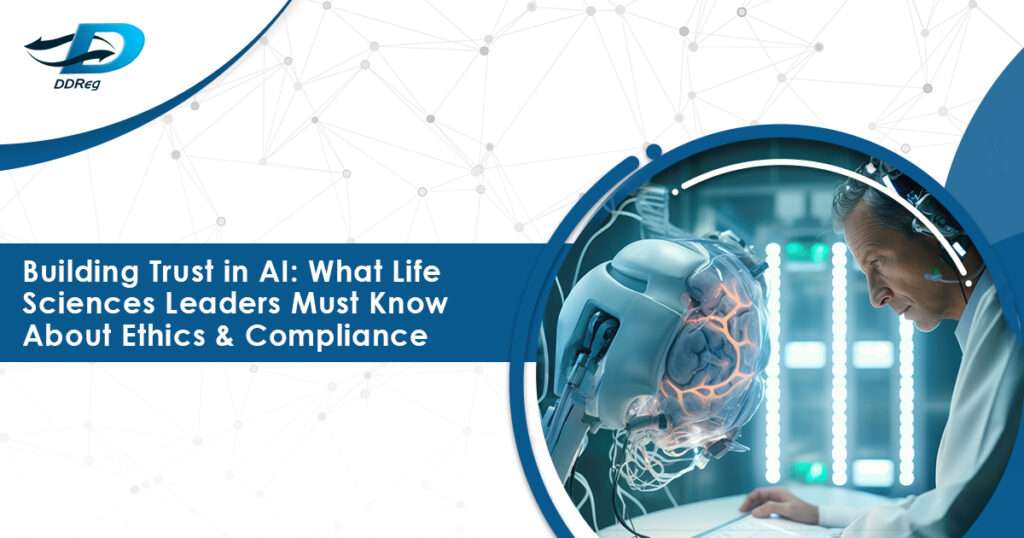
The integration of Artificial Intelligence (AI) in the life sciences sector has ushered in a new era of innovation enabling precision drug discovery, streamlining clinical trial operations, automating regulatory workflows, and personalizing therapeutic interventions. However, as AI capabilities advance, so do the ethical concerns, regulatory scrutiny, and governance challenges surrounding its responsible deployment.
This article provides an in-depth perspective on the ethical considerations, current regulatory frameworks, and governance strategies required to implement AI in drug development and commercialization. Tailored for regulatory professionals, R&D strategists, compliance leads, and digital transformation teams, this analysis is grounded in current global developments and practical implementation insights.
Ethical Considerations in AI-Driven Life Sciences Applications
AI systems in life sciences often make or support decisions with significant clinical or regulatory implications. As such, ethical AI in this domain must adhere to principles that align not only with technical robustness but also with biomedical ethics.
Core Ethical Principles of Ai in Life sciences:
- Transparency:
AI systems must provide traceable, explainable outputs especially when influencing diagnoses, trial eligibility, or regulatory filings.
- Non-maleficence and Safety:
Algorithms used in clinical or safety-related decisions must undergo rigorous validation to prevent harm.
- Equity and Bias Mitigation:
Training data must be diverse and representative to ensure that AI models do not propagate biases, particularly against underrepresented populations.
- Autonomy and Informed Consent:
Patients whose data is used for AI training or real-world evidence generation must be informed of its use, in compliance with data protection laws (e.g., GDPR, HIPAA).
- Accountability:
Human oversight must be maintained in all critical decision pathways involving AI, especially where regulatory obligations or patient outcomes are concerned.
Quasi Drugs: Regulatory & Commercial Considerations for Japan and South Korea
Key Regulatory Frameworks for AI in Life Sciences
The global regulatory landscape for AI in life sciences is rapidly evolving, with regulators now prioritizing guidance and oversight for high-risk AI applications in drug development, manufacturing, and medical devices.
European Union – AI Act 2024
Classification: AI systems used in healthcare and life sciences are categorized as high-risk.
Requirements:
- Pre-market conformity assessments
- Robust documentation (AI risk management, data governance, model transparency)
- Human oversight mechanisms
- Post-market monitoring, incident reporting
United States – FDA AI/ML Regulatory Pathway
- TPLC (Total Product Lifecycle) Approach:
Addresses ongoing learning and evolution of AI-enabled software as medical devices (SaMD).
- PCCPs (Predetermined Change Control Plans):
Allows pre-specified changes to AI models post-approval without resubmission, provided the change plan is FDA-approved.
- Guidance Areas: Clinical validation, explainability, labeling, real-world performance monitoring.
United Kingdom – MHRA AI and Digital Health Strategy
- Focused on adaptive algorithms, software as a medical device (SaMD), and regulatory innovation sandboxes.
- Emphasis on risk-based validation, algorithm update controls, and international harmonization (through the International Medical Device Regulators Forum).
International Principles
- WHO Ethical Principles for AI in Health (2021): Ethical design, safety, inclusiveness, and data stewardship.
- OECD AI Principles (adopted globally): Emphasize transparency, accountability, robustness, and democratic values.
AI Compliance in Drug Development and Commercialization
AI models span across preclinical discovery to post-market surveillance, each with unique regulatory and compliance implications. The onus is on companies to treat AI systems as regulated components subject to quality, safety, and performance controls.
Critical Areas of Compliance:
Data Governance:
GxP-aligned processes for training data acquisition, preprocessing, labeling, and storage. Requires auditability and version control of data pipelines.
Model Development and Validation:
- Model documentation including design specifications, architecture, and training parameters
- Performance metrics: Sensitivity, specificity, ROC-AUC, calibration, generalizability
- Internal and external validation datasets
- Algorithm explainability (e.g., SHAP, LIME, attention mechanisms)
Change Management:
Tracking model drift, performance degradation, and retraining cycles. Regulatory change protocols must be incorporated into software change control.
- Clinical Use and Decision Support:
Clearly defined scope of use, benefit-risk assessment, and appropriate labeling for AI that supports clinical decision-making.
- Post-Market Surveillance:
Real-world monitoring, adverse event linkage, and outcome tracking are critical, especially in dynamic AI systems.
Establishing AI Governance and Oversight Models
Effective AI governance ensures that the adoption of AI technologies is not ad hoc but structured, scalable, and compliant with internal quality systems and external regulations.
AI Governance Model for Life Sciences Organizations
Component | Description |
Governance Committee | A cross-disciplinary team comprising Regulatory Affairs, IT, QA, Clinical, and Legal functions. Oversees AI strategy, compliance, and risk management. |
AI Inventory and Risk Classification | Maintain a dynamic register of all AI systems, categorized by impact on regulatory functions, patient safety, and business operations. |
Ethical AI Policy | Define principles aligned with OECD, WHO, and local ethics committees. Establish guidelines for bias auditing, transparency, and algorithmic accountability. |
Lifecycle Management | Implement quality assurance across model development, validation, deployment, and ongoing monitoring. Align with ISO/IEC 42001:2023 (AI Management Systems). |
Internal Audits and CAPA | Perform periodic audits of AI systems. Use deviations to drive Corrective and Preventive Actions (CAPA). |
Vendor Management | Validate third-party algorithms using equivalent regulatory standards. Insist on transparency in model development and performance claims. |
Strategic Outlook for 2025 and Beyond
AI is central to the transformation of regulatory affairs, clinical development, and safety surveillance in the life sciences. Yet, without a well-defined ethical and regulatory compass, AI initiatives risk non-compliance, reputational damage, and poor patient outcomes.
Forward-looking organizations are adopting structured governance models, investing in regulatory foresight, and building internal capabilities that treat AI systems with the same rigor as traditional clinical and quality assets.
How DDReg Supports AI-Driven Regulatory Processes in Life Sciences
At DDReg, we recognize that successful AI adoption in life sciences depends on harmonizing technology with regulatory clarity and ethical rigor. We partner with pharmaceutical, biotech, and MedTech companies to embed AI capabilities responsibly ensuring that innovation is not just rapid but also robust and regulatory grade.
Let our experts help you build responsible AI capabilities with the right balance of innovation, compliance, and ethical integrity.
